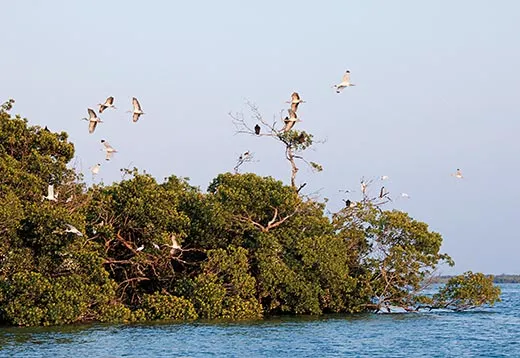Sugarloaf Key, Florida: Keeping Good Company
Observing ibises and kayaking among sharks, author Barbara Ehrenreich savors life “up the Keys”
/https://tf-cmsv2-smithsonianmag-media.s3.amazonaws.com/filer/Barbara-Ehrenreich-dock-Sugarloaf-Key-631.jpg)
In my case, anyway, geography is hard to disentangle from biography. For almost 20 years I endured the aesthetic deprivations of a lower-middle-class suburb so that my children could go to the town's first-rate public schools. Then the kids grew up and moved out and, independently of that, my marriage crumbled. I made a mad midlife dash to Key West, where I had a few friends and soon took up with a good-looking, outdoorsy local. We liked our Old Town condo well enough, but eventually, worn down by the all-night pool parties in the guesthouses next door, decided to look for a place of our own "up the Keys," where the property was cheaper and the nights still as death.
The second, and last, place we looked at was on Sugarloaf Key, a patch of land jutting out into the Gulf of Mexico from the lone highway connecting the necklace of islands that make up Florida's Keys. We drove to the end of the paved road, then onto a dirt road cutting through a low jungle of indigenous buttonwoods, poisonwoods, sea grapes and thatch palms. At the end of that was a pleasant gray house linked to the water by a boardwalk and dock, and at the end of the dock was a revelation: more than 180 degrees of turquoise water dotted with a series of tiny emerald mangrove islands. Live here, said a voice from the blue-green vastness—whatever it takes.
It took far less than it might have because the former owner had the interior decorating tastes of a serial killer. All floor space was occupied by mounds of old newspapers, receipts, porn magazines and crusty Styrofoam containers. We had the place cleaned out and painted, hauled up some used furniture from a store in Key West, and settled back to savor the gaudy sunsets and try to figure out what kind of a wild place we were settling.
Down in Key West, you can imagine you are in a patch of urban civilization, slightly shiftless and louche, but well-stocked with restaurants, supermarkets, gossip and dense human drama. In fact you could live your whole life on Key West, if you chose, without bothering to notice that you were on an island suspended more than 100 miles below the Florida peninsula in the middle of the Caribbean. But on Sugarloaf there was no evading the fragility of our existence. Under us, a thin uprising of fossilized coral; to the south, the Atlantic; to the north, the Gulf. Here, you don't think of global warming as an "issue," but as the vivid, if remote, possibility of being eaten in bed by sharks.
The very idea of an Atlantic and Gulf side is a conceit more appropriate to continent-dwellers, because there is, of course, just one all-surrounding sea. But our side, the Gulf side, a.k.a. the "backcountry," is different in ways that can make townsfolk a little uneasy. Before moving up there, I remember talking to a sponger—that is, a man who fished for sponges in the shallow transparent waters of the backcountry—and he spoke about the velvet silence of the tropical nights, the smooth undulating traffic of stingrays and sharks. But then he faltered as if there were something he couldn't figure out how to say or even whether to say it.
I wouldn't be overwhelmed, I thought, because I am a scientist or at least a scientist manquée. I could make observations—of the birds, for example. Portions of Sugarloaf are included in the Great White Heron National Wildlife Refuge, but it's the ibises that fascinate me. They tend to move in groups of 6 to 30, suggesting some rudiments of social organization. As the sun sets, they flock to a nearby mangrove island to roost for the night; at sunrise or thereabouts, they take off again for their feeding grounds. I would kayak out to watch both events. The morning liftoff can occur before or at sunrise, and it can be either messy and anarchic or a single, coordinated action involving up to 100 birds at a time. What, I wanted to know, determined the timing and nature of the liftoff? A couple of years later, when I put this question to an old friend and animal behaviorist, Jack Bradbury, a professor emeritus at Cornell University, he told me, essentially, that there were probably some leaders and trendsetters among the ibises, but there was also simply safety in traveling in numbers. In other words, within certain parameters like hunger and the need to stick together, they do pretty much what they damn well please.
The dolphins, though, became the freewill stars of my new cosmos. I'd never know when or where I'd run into them, in what season or depth of water, and whether it would be a single one or a pod. I was out on my kayak one day when I noticed some furious splashing off to the north. Paddling to the action as fast I could, I saw two dolphins playing some rough, elegant game involving alternating leaps out of the water, and when they saw me, they decided to include me in it. They'd swim alongside the kayak, then vanish under it and pop up dramatically on opposite sides with those wide dolphin grins on their faces. This went on for about a half-hour, until they zipped off to find a better player.
Meanwhile things were not going well with the one human in my daily life. It turned out he acutely missed Key West, where his afternoon round of errands on bike could easily involve a half-dozen conversations. On Sugarloaf, our nearest errand destination was Jen's grocery store, three miles away, where we got our newspapers, mail and a little chatter about, say, a crocodile sighting or the possibility of a front coming through. ("Weather" is too static a word for what we have in the Keys; instead we have "fronts.") My companion wanted to spend more long, boozy evenings in Key West with friends. I didn't want to miss a sunset, a moonrise or whatever other show might be playing.
And there was so much going on, especially in spring and summer when the water cycle goes into overdrive. All day the sky sucks steam from the warm seas, dumping it back in the psychotic violence of a late afternoon squall, then finishing up with a sweet consoling rainbow. You might get waterspouts skidding across the Gulf in late summer, miniature tornadoes that mainly bother the birds but can take off a roof. One July night, we stepped outside to find the horizon ringed with at least six discrete lightning storms, each in its own separate sphere of pyrotechnics, leading my friend—a man not known for metaphysical pronouncements—to mutter, "There is a God."
Was it a god? I am not a religious person, but I began to understand that I was being drawn into something, maybe into that very thing that the sponger had hesitated to describe. I came to think of it as the Presence, what scientists might call an "emergent quality," something greater than the sum of all its parts—the birds and cloudscapes and glittering Milky Way—that begins to feel like a single living, breathing Other.
It is not always benevolent, this Presence. Oh, it can be as seductive as the scent of joewood flowers riding on a warm November breeze, as uplifting as the towering pink, self-important, Maxfield Parrish-type cumulus clouds that line up to worship the rising sun. But then, just like that, it can turn on you. I've gone out on the water on a perfectly inviting day only to find myself fighting for my life against a sudden wind and seas that had turned into foam. I learned to take kayaking more seriously—never going out without a water bottle, some trail mix and a plastic container for bailing. I learned to keep going when survival was not guaranteed, did not even seem likely, by uttering a loud, guttural "unhh!" with each stroke of the paddle—who was there to hear?—as a way of transcending exhaustion and fear.
When my companion and I separated, I held on to Sugarloaf and still go there when I can afford to and don't have a tenant. I get up at sunrise and go down to the dock to check out the fauna—the parrotfish, the snappers, maybe a barracuda or, most recently, a fair-sized octopus. At high tide, and if the wind permits, I kayak out to the still, sheltered spots in the mangrove islands where I know I can find little sharks, two to three feet long, to keep me company. In the evening, after watching the sun set, I have my white wine and grill some local grouper or mahi-mahi. All this may sound unenviably solitary, but do not imagine that I am alone.
Barbara Ehrenreich's most recent book is This Land Is Their Land: Reports From a Divided Nation.



